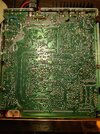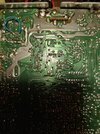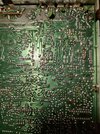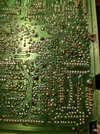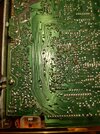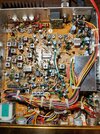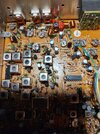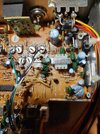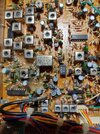Got a Ranger SS3900EGHP (aka...American Spirit) on the desk today that's completely dead as far as receive and transmit.
Issues:
Powers on fine, all lights work, receive/transmit light switches when keying and unkeying as it should.
No receive, just light hash noise with volume wide open.
No transmit, not even a flicker when keyed.
No indication of output on monitor set on same channel.
No indication of receive when keying monitor radio on same channel.
VCO voltage will adjust smoothly from 1v up to over 8v, it's set at 1.65 for band A as service manual suggest.
The 10.240mhz crystal frequency is present and steady on pin 4 of the PLL at 10.239.9mhz.
I'll upgrade some pics in a bit.
Note:
There are signs of trace damage in several areas that were previously repaired, although not the way I would have fixed them, none the less there are no issues with the previous repairs other than cosmetically.
Nothing is getting hot, although the audio IC does get warm, not hot just warm.
Issues:
Powers on fine, all lights work, receive/transmit light switches when keying and unkeying as it should.
No receive, just light hash noise with volume wide open.
No transmit, not even a flicker when keyed.
No indication of output on monitor set on same channel.
No indication of receive when keying monitor radio on same channel.
VCO voltage will adjust smoothly from 1v up to over 8v, it's set at 1.65 for band A as service manual suggest.
The 10.240mhz crystal frequency is present and steady on pin 4 of the PLL at 10.239.9mhz.
I'll upgrade some pics in a bit.
Note:
There are signs of trace damage in several areas that were previously repaired, although not the way I would have fixed them, none the less there are no issues with the previous repairs other than cosmetically.
Nothing is getting hot, although the audio IC does get warm, not hot just warm.

